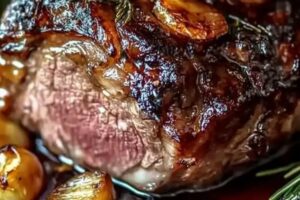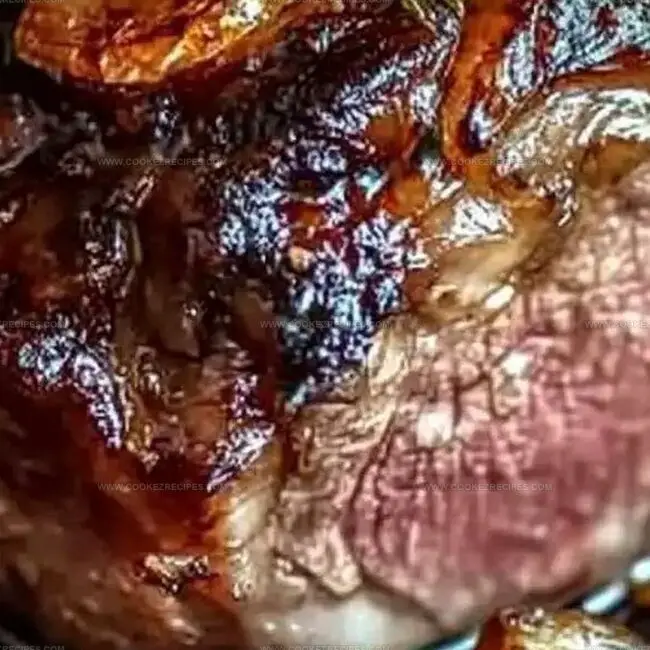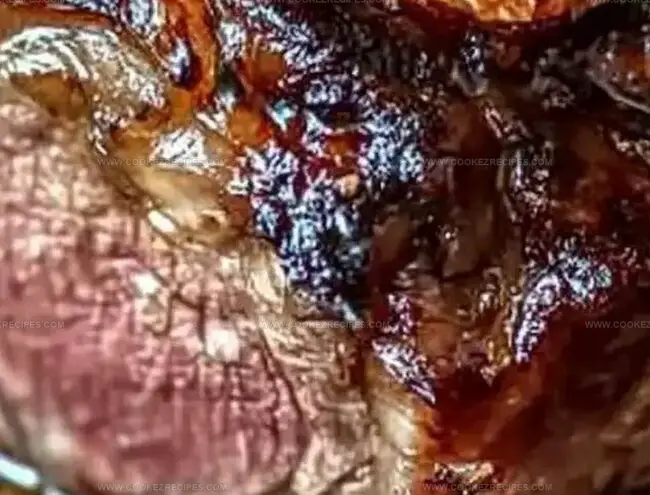Juicy Rosemary-Glazed Slow-Roasted Lamb Shoulder Recipe
Succulent and aromatic slow-roasted lamb shoulder whispers tales of Mediterranean culinary magic.
Rustic kitchens buzz with anticipation when this recipe emerges.
rosemary-infused meat promises a symphony of deep, complex flavors.
Gentle cooking techniques unlock incredible tenderness that melts effortlessly on your tongue.
Each bite transports you to sun-drenched hillsides where herbs grow wild and free.
Passionate cooks understand that patience transforms simple ingredients into extraordinary experiences.
Let this extraordinary dish become your weekend celebration of comfort and joy.
What Makes Tender Slow Roasted Lamb Shoulder Irresistible
Lamb Shoulder with Rosemary Ingredients
Meat:Herbs and Aromatics:Seasoning and Liquid Components:Glaze Ingredients:Slow-Roasted Lamb Shoulder Rosemary Prep
Step 1: Warm Up the Oven
Fire up your oven to a cozy 300°F.
This low and slow temperature will help transform your lamb into a melt-in-your-mouth masterpiece.
Step 2: Massage the Meat
Gently pat the lamb shoulder dry with paper towels.
Create a flavor-packed rub by mixing:Lovingly massage this aromatic mixture all over the lamb, ensuring every inch is covered with deliciousness.
Step 3: Begin the Slow Roast
Nestle the lamb into a roasting pan.
Pour around the meat:Wrap the pan tightly with aluminum foil and let the lamb slowly cook for 3-3.5 hours.
The meat should become so tender it falls apart with a gentle touch of a fork.
Step 4: Craft the Glorious Glaze
While the lamb roasts, whip up a tantalizing glaze by whisking together:Step 5: Caramelize and Shine
After the initial roasting, remove the foil and brush the lamb generously with the glaze.
Return to the oven uncovered for 20-30 minutes, basting occasionally until the exterior transforms into a golden, caramelized work of art.
Step 6: Rest and Serve
Let the lamb rest for 10 minutes after removing from the oven.
This allows the juices to redistribute, ensuring maximum tenderness.
Slice and serve, drizzling the pan juices over the meat for an extra burst of flavor.
Roasting Tips for Lamb Shoulder
Lamb Shoulder Storage & Reheating
Lamb Shoulder Add-Ons You’ll Love
Slow-Roasted Lamb Shoulder With Seasoning Swaps
FAQs
The slow roasting process at a low temperature breaks down the tough connective tissues, resulting in incredibly soft and melt-in-your-mouth meat. The long, gentle cooking allows the lamb to become fork-tender and develop rich, deep flavors.
Yes, you can substitute dried rosemary, but use about one-third the amount of fresh rosemary. Dried herbs are more concentrated, so reduce the quantity to prevent overpowering the dish’s delicate flavor profile.
You’ll only need a roasting pan, aluminum foil, and a small bowl for mixing the herb rub and glaze. A meat thermometer can be helpful to ensure perfect doneness, but it’s not absolutely necessary.
The lamb is ready when it’s fork-tender and easily falls apart when pierced with a fork. This typically occurs after 3-3.5 hours of slow roasting at 300°F. The meat should be so tender that it practically melts in your mouth.
Print
Tender Slow-Roasted Lamb Shoulder Glazed with Rosemary Recipe
- Total Time: 3 hours 45 minutes
- Yield: 6 1x
Description
Rosemary-infused lamb shoulder promises a culinary journey through Mediterranean flavors, melting hearts with its rich, succulent profile. Herb-crusted and slow-roasted to perfection, you’ll savor each tender bite of this elegant dish that whispers comfort and tradition.
Ingredients
Lamb Ingredients:
- 4 pounds (1.8 kilograms) bone-in lamb shoulder
- 1 cup (240 milliliters) dry white wine (or chicken broth)
- 4 garlic cloves, minced
- 2 tablespoons fresh rosemary, chopped
- 1 tablespoon olive oil
- 1 teaspoon salt
- 1/2 teaspoon black pepper
- 1 tablespoon lemon juice
Glaze Ingredients:
- 3 tablespoons honey
- 2 tablespoons Dijon mustard
- 1 tablespoon fresh rosemary, chopped
- 1 tablespoon olive oil
- 1 teaspoon balsamic vinegar
- Salt, to taste
- Pepper, to taste
Instructions
- Carefully pat the lamb shoulder completely dry using clean paper towels to ensure optimal seasoning adherence and crisp exterior development.
- Create a robust herb-infused rub by blending minced garlic, freshly chopped rosemary, olive oil, sea salt, and cracked black pepper into a fragrant paste.
- Massage the aromatic herb mixture thoroughly into every crevice of the lamb shoulder, ensuring comprehensive flavor penetration.
- Position the seasoned lamb shoulder inside a deep roasting pan, then gently pour white wine and fresh lemon juice around the meat to create a flavorful braising liquid.
- Completely seal the roasting pan with aluminum foil, creating a tight moisture-trapping environment for slow, gentle cooking.
- Roast the lamb in a preheated 300°F (150°C) oven for approximately 3-3.5 hours, allowing the meat to become exceptionally tender and succulent.
- Midway through roasting, whisk together a luxurious glaze combining honey, Dijon mustard, additional rosemary, olive oil, balsamic vinegar, salt, and pepper.
- After initial roasting, uncover the lamb and generously brush the prepared glaze across the entire surface, creating a beautiful caramelized coating.
- Return the glazed lamb to the oven uncovered, basting periodically to enhance color and develop a rich, glistening exterior.
- Once the glaze transforms into a golden, slightly crisp layer, remove the lamb from the oven and allow it to rest for 10 minutes.
- Slice the lamb against the grain and serve immediately, drizzling remaining pan juices over the meat for added moisture and flavor complexity.
Notes
- Choose a high-quality, well-marbled lamb shoulder for maximum tenderness and rich flavor.
- Marinate the lamb overnight in the herb mixture to enhance depth of flavor and ensure more intense seasoning.
- Consider trimming excess fat, leaving a thin layer to keep the meat moist during slow roasting.
- For gluten-free adaptation, replace Dijon mustard with a certified gluten-free version or use whole grain mustard.
- Low and slow cooking guarantees melt-in-your-mouth texture, so avoid rushing the roasting process.
- Use a meat thermometer to check internal temperature, aiming for 145°F for medium-rare or 160°F for medium doneness.
- Fresh rosemary delivers superior flavor compared to dried herbs, so invest in quality sprigs.
- Prep Time: 15 minutes
- Cook Time: 3 hours 30 minutes
- Category: Dinner
- Method: Roasting
- Cuisine: Mediterranean
Nutrition
- Serving Size: 6
- Calories: 490
- Sugar: 7 g
- Sodium: 640 mg
- Fat: 30 g
- Saturated Fat: 9 g
- Unsaturated Fat: 19 g
- Trans Fat: 0 g
- Carbohydrates: 17 g
- Fiber: 0 g
- Protein: 37 g
- Cholesterol: 105 mg




Katherine Pierce
Recipe Curator & Food Educator
Expertise
Education
Boston University Metropolitan College
Certificate Program in the Culinary Arts
Focus: French and international cuisine techniques, Hands-on culinary training with industry professionals, Food industry insights and operations
Katherine grew up believing every dish has a story. She studied the art of food at Boston University and explored the history behind it. She loves pulling easy recipes from every corner of the world and putting them at your fingertips.
When Katherine’s not writing or testing new flavors, she’s teaching cooking classes, baking colorful mooncakes, or dreaming up new ways to mix old favorites with new twists.